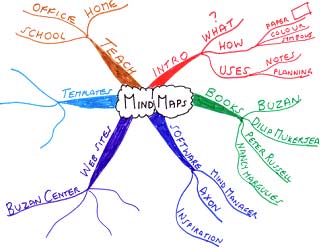 The human brain is very different from a computer. Whereas a computer works in a linear fashion, the brain works associatively as well as linearly - comparing, integrating and synthesizing as it goes. Association plays a dominant role in nearly every mental function, and words themselves are no exception. Every single word, and idea has numerous links attaching it to other ideas and concepts.
The human brain is very different from a computer. Whereas a computer works in a linear fashion, the brain works associatively as well as linearly - comparing, integrating and synthesizing as it goes. Association plays a dominant role in nearly every mental function, and words themselves are no exception. Every single word, and idea has numerous links attaching it to other ideas and concepts.
Mind Maps, developed by Tony Buzan are an effective method of note-taking and useful for the generation of ideas by associations. To make a mind map, one starts in the centre of the page with the main idea, and works outward in all directions, producing a growing and organized structure composed of key words and key images. Key features are:
- Organization
- Key Words
- Association
- Clustering
- Visual Memory - Print the key words, use colour, symbols, icons, 3D-effects,arrows and outlining groups of words
- Outstandingness - every Mind Map needs a unique centre
- Conscious Involvement
Mind Maps are beginning to take on the same structure as memory itself. Once a Mind Map is drawn, it seldom needs to be referred to again. Mind Maps help organize information. Because of the large amount of association involved, they can be very creative, tending to generate new ideas and associations that have not been thought of before. Every item in a map is in effect, a centre of another map.
The creative potential of a mind map is useful in brainstorming sessions. You only need to start with the basic problem as the centre, and generate associations and ideas from it in order to arrive at a large number of different possible approaches. By presenting your thoughts and perceptions in a spatial manner and by using colour and pictures, a better overview is gained and new connections can be made visible.
Mind maps are a way of representing associated thoughts with symbols rather than with extraneous words something like organic chemistry. The mind forms associations almost instantaneously, and "mapping" allows you to write your ideas quicker than expressing them using only words or phrases.